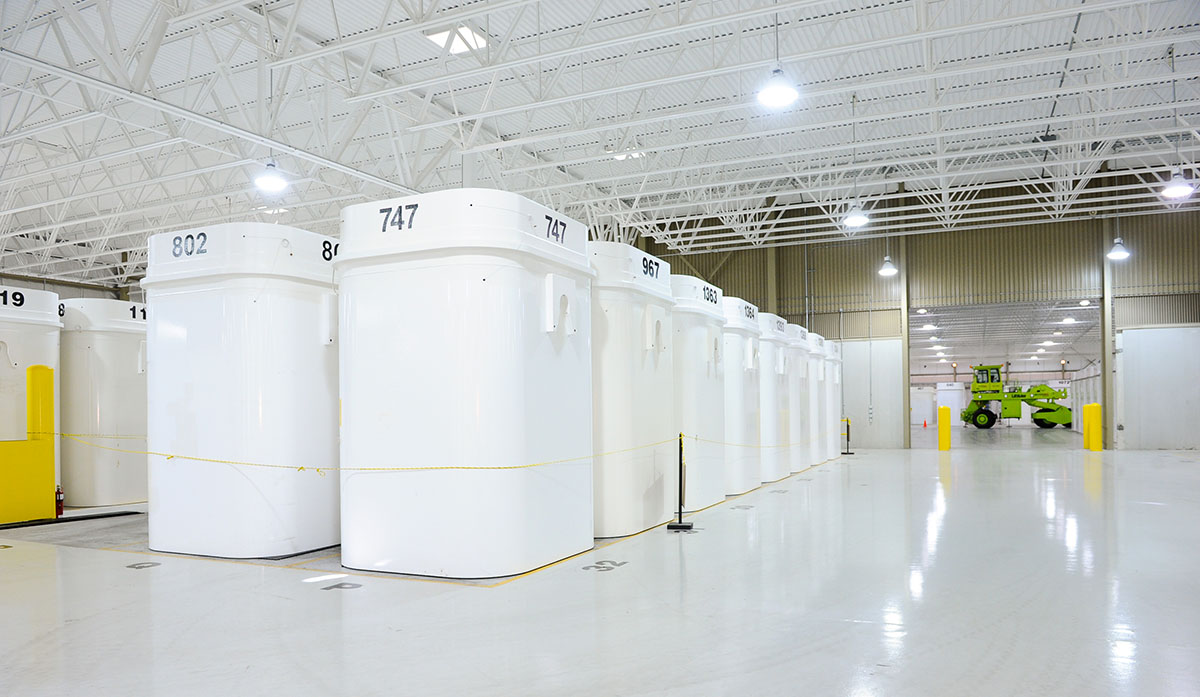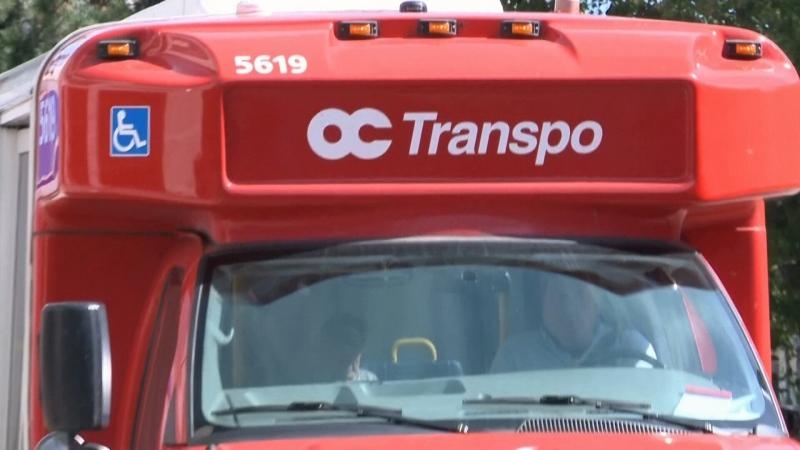
Algonquin Nations Oppose New Nuclear Dump Site at Chalk River
ABOVE: After fuel bundles ‘cool’, OPG uses dry storage containers made of concrete and steel that are designed to last for more than 50 years. (PHOTO: OPG)
Algonquin First Nations are calling on the Federal Government and Canadian Nuclear Laboratories (CNL) to shelve a planned nuclear waste facility in Chalk River, Ontario, less than 200km from Ottawa.
On June 20, the Chiefs of Kebaowek First Nation, Kitigan Zibi First Nation, the Algonquin Secretariat and the Algonquin Anishinaabeg Nation Tribal Council, which represents seven Algonquin Nations, spoke up about their opposition to the proposed location of the near-surface disposal facility (NSDF).
The NSDF will stand one kilometre from the Ottawa River, or Kichi Sibi in Algonquin, where most residents in and around Ottawa get their drinking water.
CNL hopes to clean up historical radioactive waste around the country and store it in the NSDF. This includes waste from nuclear research facilities, shut-down nuclear reactor sites, uranium mines, and debris from the demolition of building 250, one of the oldest Chalk River power plant buildings.
The NSDF is slated to store solid waste in the ground, protected by a system that catches runoff before it makes it into the Ottawa River. Accompanying the project is a water treatment system to eradicate radium from radioactive water before sending it into the Ottawa River. The project is expected to take three years and cost $750 million, after costs of operation, closure, maintenance, and surveillance.
Nearby Algonquin communities are concerned about the well-being of the plants and wildlife that inhabit the area, as well as the contamination of the Ottawa River.
Last year, the Canadian Nuclear Safety Commission (CNSC) paused its hearings to give First Nations more time to weigh in on the idea. At the time, Counsellor Justin Roy of Kebaowek First Nation saw the agreement as a ‘huge victory’. Now, the Kebaowek Chief, Lance Haymond, among others, sees it as insufficient time. “In our findings, there are huge gaps . . . and based on that reality, there was not adequate time for us to have been consulted and therefore make an informed decision to provide consent,” he said.
Now eight months later, the CNSC and federal government are looking for answers. At the June 20th conference, various chiefs expressed that eight months is a short time frame given the challenges of negotiating funding agreements for the appropriate Indigenous-led environmental assessments. Given the time they had, their assessment found the proximity of the NSDF to the Ottawa River to be a red flag.
The Algonquins of Pikwakanagan do not disagree with the proposed disposal site and signed a long-term relationship agreement with CNL and Atomic Energy Canada. However, Kebaowek, and Kitigan Zibi among others stand their ground.
Much of the doubt stems from memories of Chalk River’s past. The Chalk River power plant is the site of two nuclear accidents; the first (and one of the first in the world) occurred in 1952 when a reactor raced out of control, overheated, and exploded, destroying the core and releasing radioactive gases and debris into the atmosphere. A long, expensive cleanup was conducted for years to dispose of the radioactive waste from the accident, including the underground storage of solid waste and man-made pits to contain liquid.
Decades later, traces of lower-level waste leakage were found in soil, small lakes, groundwater, and part of the Ottawa riverbed. Two of the most common radioactive contaminants were cesium-137, widely used in nuclear-measuring gauges, and strontium-90, found in reactor waste. Tritium, a low-energy radioactive form of hydrogen, was found in the river as well, and other industrial substances, including polychlorinated biphenyls, lead, and mercury, escaped too.
CNSC and Atomic Energy Canada have stated that the materials from the 1952 accident pose a low risk to the public and the environment. Over 70 years later, they are confident in their ability to prevent any harm with projects like the NSDF.
For many, the uncertainty seems to come from a doubt in communication. Back in 2009, Liberal Ottawa South MP David McGuinty spoke up about how little people knew about the aftermath of nuclear accidents. “We are finally tabling a report confirming the radioactive leaks, both liquid and gaseous, at Chalk River. The Conservatives have known, apparently, everyone knew, except 33 million Canadians . . . if the info had not been leaked to the media, would Atomic Energy Canada acknowledge the facts, and would Canadians have ever known?”
Kitigan Zibi Chief Dylan Whiteduck points out that there needs to be more federal government coverage of projects like the NSDF. “I’m very shocked that the citizens of Ottawa are not aware of this. I have talked to many . . . and they have no idea about nuclear waste two hours away from their home,” he said.
The First Nations, whose traditional territories circle the Ottawa River, are not the only ones against the NSDF; dozens of Montreal mayors with the Montreal Metropolitan Community unanimously oppose it. Maja Vodanovic from Montreal’s borough of Lachine said: “Nuclear energy is not clean energy. Yes, it doesn’t produce the same greenhouse gas effects as oil, but it creates very dangerous waste.”
Should we be afraid?
Nuclear energy has seen a rise over the last few years. It has provided incredible opportunities to nations worldwide, creating energy in reliable and cost-effective ways. Nuclear power is one of the most low-carbon energy sources and is seen as one of the answers to the energy gap.
Nuclear power is a new way of generating energy, and experts are still learning every year. Every major form of energy generation has its consequences. While nuclear power has one of the smallest carbon footprints, the consequences of mistakes are different from what humans have been used to.
When it comes time to dispose of nuclear waste, including spent reactor fuels, uranium mill tailings, and more, these materials can remain radioactive for years. If not dealt with carefully, radioactivity can be devastatingly harmful to nature and humans exposed to it. Because of these risks, safety is always the primary concern.
Since the beginning of nuclear power, accidents have happened. The 1986 Chernobyl reactor explosion is the most well-known horror story that released monumental amounts of radiation into the atmosphere in Ukraine. In 2011, an earthquake and tsunami destroyed the Fukushima Daiichi power plant in Japan, contaminating the entire surrounding area. Disasters like these loom and paint a grim picture.
As Japan gears up to release the stored wastewater from the Fukushima Daiichi disaster into the Pacific Ocean, talk of the consequences of nuclear power is at an all-time high. The wastewater was contaminated with 64 radioactive elements, known as radionuclides. It has been stored and treated since the incident to minimize radioactivity. Pacific countries nearby have expressed their worry about the contamination of fish and, eventually, the ocean’s food web, but the International Atomic Energy Agency (IAEA) has approved the project to be safe.
Decisions like this are up to the approval of the IAEA, but neighbouring countries, including South Korea and the Philippines, have pleaded with Japan to reconsider.
In Europe, Ukraine is dealing with the aftermath of the destruction of the Kakhovka dam. The dam held a reservoir which provided water used for cooling reactors at the Zaporizhzhia plant. The disaster has heightened the risk of a nuclear accident, which is already heightened by ongoing combat in the area. The plant has taken the appropriate precautions, and most of the plant’s reactors are in cold shutdown.
While disasters like these are terrifying and surreal, they have been mistakes to learn from. Several billion dollars go into nuclear power to ensure that history does not repeat itself.
A project like the Chalk River NSDF poses no risk of a meltdown disaster. Instead, it is meant to hold old materials in one place, similar to a landfill, until the radioactivity decreases. The only threat would be the leakage of radioactive materials into the ground or nearby water supply, and heavy precautions have been taken to counteract such incidents. In a statement, CNL said the waste disposal facility will be built carefully on a containment mound and ‘has been planned and designed to be fully protective of the Ottawa River.’
CNL says that after its first century, the NSDF radioactivity will reduce to background levels. In 500 years, they say, people could live on top of it.
While nuclear energy continues to see significant developments in research and regulations, the risks are very real and something everyone should be aware of. A nuclear dump site on someone else’s land is a big ask, and the Algonquin people feel that they deserve more time as protectors of the land, especially with such an important river involved. “The Kichi Sibi is sacred to our peoples and at the heart of our unceded homeland,” said Chief Lance Haymond, “The Algonquin peoples never consented to the Chalk River site being used for over 75 years for nuclear reactors and research, and now a permanent waste dump. The consultation was far too late and inadequate, and we reject the plan.”
Kitigan Zibi chief Dylan Whiteduck agrees. “At no time in our consultations has anyone provided any justification for putting it so close to the Kichi Sibi.” He states, “We have found very severe potential impacts to our Indigenous rights and interests from the radioactive waste mound. To have any meaning, the consultation has to start back from the very beginning of project planning.”
The Algonquin Nations say that the CNSC has failed to fulfill its duty to consult and that greenlighting the project would violate Article 29(2) of the United Nations Declaration on the Rights of Indigenous Peoples (UNDRIP).
Dr. Gordon Edwards of the Canadian Coalition for Nuclear Responsibility responded to the discussion by saying: “The CCNR does not presume to speak on behalf of Indigenous people, but as Canadian citizens, we wish to state clearly and unequivocally that if CNSC approves the NSDF despite the lack of free, prior, and informed consent from the Kebaowek and Kitigan Zibi First Nations, we will consider this act as one that dishonours Canada and all Canadians.”
The Algonquin Nations will present their conclusions about the waste facility at the Canadian Nuclear Safety Commission hearing on August 10.








